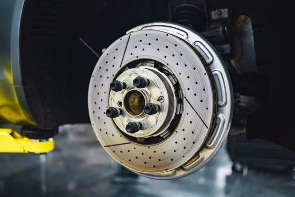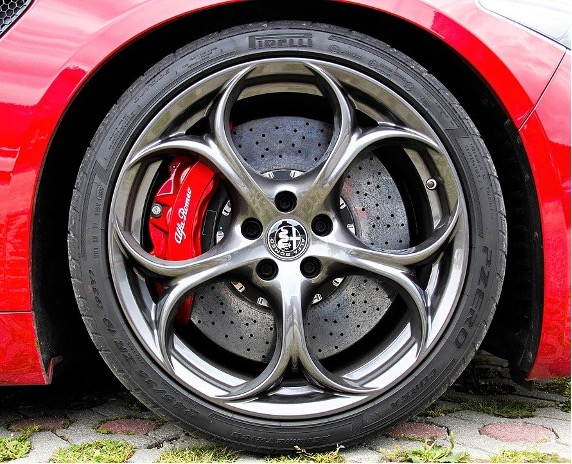The past and future of brake systems
We rarely deal more closely with the brakes of our own vehicles. The interventions are mostly limited to replacing the pads and discs, lot of people do not even observe the mandatory brake fluid replacement interval. They act like this even though the brake is probably the most important subsystem of road vehicles in terms of safety.
The past
Despite the fact that the importance of the brake is no longer in question, when cars appeared today they were able to produce a small deceleration and were extremely complicated, difficult-to-manage systems.
Constructors preferred to build engines rather than brake systems more than a hundred years ago. Then reality prevailed: passenger cars became too powerful and fast for the 1910s and 1920s. It was necessary to be able to apply the brakes. To be precise, in most cases, we are not talking about a step, but a manual intervention: the band brakes had to be operated by hand.
Drum brakes mounted on axles were already in the experimental phase at the beginning of the 1900s. They were still built outside, and due to the uncomfortably high thermal expansion in the heat, it was not advisable to use them on serpentines. The service interval was roughly 500 kilometers (!).
A few years later, the two drum brakes of the rear axle were placed inside the wheel, so it was less sensitive to weather conditions. Because at that time only the rear axle was braked. Their lifetime was 1600 kilometers then.
The drum brake is still existing in the automotive industry, although today it is only common in the smaller size categories, even then only on the rear axle, possibly as a handbrake.
The origins of disc brakes are complicated like anything which worth a lot of money. Although they started to be used in series in the 50s, the braking principle itself already existed in 1898, a person called Elmer Ambrose Sperryinstalled them on his own electric car and the brake was also fully electrically operated. This also shows that the origins of electric cars and brake-by-wire are much older than we might think at first.
In 1953, Dunlop already came up with a disc brake system very similar to nowadays’ solution, which was installed in the C-Type Jaguar. It was not the first vehicle with disc brakes, but it is still considered a milestone in a technical way.
This is where the improvements have started: types of saddles, vacuum assistance, hydraulics, air brakes, ABS and other auxiliary electronics.
Subtypes of disc brakes
Floating caliper disc brake: As with everything, they soon started to check the possibilities of cutting the budget. Soon, the family of floating caliper brakes – which has spread in enormous numbers since then – was born and of which several versions are running on the roads. Their essence is common: there are pistons on only one side, and the other side of the saddle can also press against the disc during operation, since it does not have a fixed position. Hence the name “floating”.
It depends on the design which side does not have a piston, but the basic principle is always to eliminate the working cylinders where cooling is less effective.
Floating caliper disc brake: This can be found in most small and mid-range passenger cars. It got its name from the fact that its closing mechanism resembles to a clenched fist. Both sides of the saddle are pulled together by guide pins that are very well hidden and protected from all external influences. Its installation is easier than that of a fixed saddle, but this can also be said in general. Let’s see one in action:
Framed floating caliper disc brake: This is almost exactly the same as the previous one, only here there is a complete frame around the pads. Due to the compression of the piston (row), it not only presses the insert on its own side, but also pulls the frame on itself, so that also compresses the other insert.
Combined disc brake with floating caliper: There is a small problem with both of the aforementioned brakes, especially with the first one – they can only be loaded to a limited extent compared to fixed calipers. Therefore, so that heavier vehicles do not have to be equipped with a fixed fifth wheel system, a combination of two floats was invented, which already allows sufficient operating force even for the category of light trucks.
Materials
How much the brake disc/brake pad can be loaded, and how long we can do this, depends on the chosen materials. In general, the saddle and the disc almost always have some kind of steel base, with brake pads the variance is a bit larger.
Obviously, the exact composition is not made public by the manufacturers, but we know the basic uses: the so-called friction material that comes into contact with the disc consists of a mixture of binders (e.g. resin), fillers (e.g. iron oxide), lubricants (e.g. graphite) and metals (e.g. steel fabric). Today, not all inserts contain steel, they are also manufactured using ceramic processes.

Drilled, grooved brake disc (source:www.pexels.com)
It is also clear that it can be used for active and passive cooling of the brakes. For example, the various holes and grooves on the brake discs, or the hollows drilled into the disc’s robe are used for this purpose, with which we can achieve a cooling efficiency of up to 20-30%.

Carbon-ceramic brake disc (source: www.pixabay.com)
In any case, we must also mention the carbon-ceramic brake discs, which we could believe were created for their durability, although this was not the main point. In motorsport, the weight of the vehicle is of critical importance, so everything is done to make it easier. A complete set of saddles does not weigh more than 6 kilos in the current Formula 1, in the case of steel, it is almost three times that.
In addition to this, of course, it is also true that it withstands heat loads much better than steel, and because of this it is used much later.
The spread of electric cars changed something
With the spread of hybrid and electric cars, it became possible to recover some kinetic energy that occurs during braking , which can be returned to the battery.
This recuperation made it possible to protect the brake system of the same size much better, thus ensuring much longer replacement intervals for pads and discs.
One of the current shortcomings of BEV vehicles is weight: in their category, they can weigh hundreds of kilograms more than their counterparts with internal combustion engines. We could conclude that these cars require stronger brakes, but the regenerative brake assist compensates a lot for this disadvantage.
It is also important to note that, despite the above, manufacturers usually oversize the brakes for electric cars as well, so customers usually perceive increased braking performance compared to what they experienced before.
Looking to the future, the spread of brake-by-wire systems is almost unquestionable, it is due to the increased electrification on one hand, on the other hand due to the much easier programmability for self-driving and driving support systems.
It is often mentioned as an argument in favor of the system that it is easier to manage, because brake fluid, working cylinders and other elements that were part of the hydraulic system are not required anymore. It is important to mention here that this is still not true today, because today’s cars equipped with a brake-by-wire system still have the hydraulic brake as a redundant subsystem in case of an electrical malfunction in the vehicle.
Source: https://racseblog.hu/2021/02/13/ha-nincs-ami-megallit/













